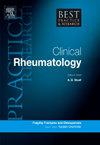大血管炎的最新成像技术。
IF 4.8
2区 医学
Q1 RHEUMATOLOGY
Best Practice & Research in Clinical Rheumatology
Pub Date : 2025-09-01
DOI:10.1016/j.berh.2025.102060
引用次数: 0
摘要
诊断性影像学推荐用于确认疑似巨细胞动脉炎(GCA)或高须动脉炎(TAK),并可在这些患者的随访中用于评估血管损伤。超声、磁共振成像(MRI)和18f -氟脱氧葡萄糖(18F-FDG)正电子发射断层扫描(PET)/计算机断层扫描(CT)都可以显示受影响血管区域的炎症。超声和MRI分别被推荐为GCA和TAK的一线诊断检查,但当地专业知识、可用性和潜在的鉴别诊断是选择成像方式的重要先决条件。超声,磁共振和ct血管造影也可用于评估形态变化。有必要进一步研究影像学在监测疾病活动和指导治疗决策方面的作用。优点和局限性分别适用于所有模式。本文将讨论这些成像方式在GCA和TAK的诊断和治疗中的优缺点、应用和缺陷。本文章由计算机程序翻译,如有差异,请以英文原文为准。
Update in imaging for large vessel vasculitis
Diagnostic imaging is recommended to confirm suspected giant cell arteritis (GCA) or Takayasu arteritis (TAK), and may, in the follow-up of these patients, be used to assess vascular damage. Ultrasound, magnetic resonance imaging (MRI) and 18F-Fluorodeoxyglucose (18F-FDG) positron emission tomography (PET)/computed tomography (CT) can all visualise inflammation in vascular regions affected. Ultrasound and MRI are recommended first line diagnostic test in GCA and TAK, respectively, but local expertise, availability and potential differential diagnoses are important prerequisites for the choice of imaging modality. Ultrasound, MR- and CT-angiography may also be used to assess morphologic changes. Further research is necessary on the role of imaging for monitoring disease activity and guide treatment decisions. Advantages and limitations apply to all modalities separately. This review will discuss the pros and cons, the application and pitfalls of each of these imaging modalities in the diagnosis and management of GCA and TAK.
求助全文
通过发布文献求助,成功后即可免费获取论文全文。
去求助
来源期刊
CiteScore
9.40
自引率
0.00%
发文量
43
审稿时长
27 days
期刊介绍:
Evidence-based updates of best clinical practice across the spectrum of musculoskeletal conditions.
Best Practice & Research: Clinical Rheumatology keeps the clinician or trainee informed of the latest developments and current recommended practice in the rapidly advancing fields of musculoskeletal conditions and science.
The series provides a continuous update of current clinical practice. It is a topical serial publication that covers the spectrum of musculoskeletal conditions in a 4-year cycle. Each topic-based issue contains around 200 pages of practical, evidence-based review articles, which integrate the results from the latest original research with current clinical practice and thinking to provide a continuous update.
Each issue follows a problem-orientated approach that focuses on the key questions to be addressed, clearly defining what is known and not known. The review articles seek to address the clinical issues of diagnosis, treatment and patient management. Management is described in practical terms so that it can be applied to the individual patient. The serial is aimed at the physician in both practice and training.

 求助内容:
求助内容: 应助结果提醒方式:
应助结果提醒方式:


